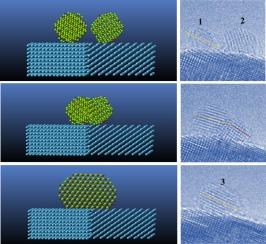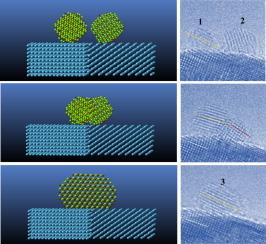初氧化AuCu纳米合金的表面结构依赖成核和旋转烧结
IF 6.9
2区 材料科学
Q2 CHEMISTRY, PHYSICAL
引用次数: 0
摘要
AuCu纳米合金是典型的多组分催化剂,因其成本低廉而得到广泛应用。氧化是催化过程中非常常见的一种反应方式,其中材料的形态、组成和表面缺陷都会影响氧化的起始和加剧氧化。采用原位环境透射电镜观察了原子尺度氧化过程对AuCu纳米晶膜吸附、成核和生长的影响。揭示了不同类型缺陷对氧化物成核过程的结构影响,优选的氧化顺序是表面晶界优先,然后是表面锯齿形边缘,最后是有序晶面。这种结构的氧化顺序可以归因于AuCu纳米合金的配位数,配位数大的纳米合金倾向于吸附更多的氧原子,并倾向于在该区域成核。新形成的氧化晶体的成核和生长是无序的,导致结构有序。氧化过程促使氧化物颗粒旋转,而这种旋转加速了颗粒的结合。对氧化过程中AuCu合金微观组织的原位研究为研究纳米合金催化性能失效机理提供了重要依据。本文章由计算机程序翻译,如有差异,请以英文原文为准。


Surface structure-dependent nucleation and rotated sintering of an initially oxidized AuCu nanoalloy
AuCu nanoalloys are typical multicompent catalysts that have been widely used because of their highly reduced cost. The oxidation is a highly common reaction mode during catalysis, in which the material morphology, composition, and surface defects can affect the initiation of oxidation and aggravate the oxidation. The effects of the atomic-scale oxidation process on the adsorption, nucleation and growth of the AuCu nanocrystalline films were observed by in situ environmental transmission electron microscopy. The structural impacts of different types of defects on the oxide nucleation process have been revealed, and the preferred oxidation sequence is surface grain boundaries first, then surface zigzag edges, and, finally, the orderly crystal surface. Such a structural oxidation sequence can be attributed to the coordination number of AuCu nanoalloys, with those with large numbers tending to adsorb more oxygen atoms and preferring to nucleate in this region. Nucleation and growth on the newly formed oxide crystal were disordered, resulting in structural order. The oxidation process prompts oxide particle rotation, and this rotation accelerates the combination of particles. An in situ study of the microstructures of a AuCu alloy subjected to oxidation provides key evidence for studying the failure mechanism of the catalytic properties of nanoalloys.
求助全文
通过发布文献求助,成功后即可免费获取论文全文。
去求助
来源期刊

Applied Surface Science
工程技术-材料科学:膜
CiteScore
12.50
自引率
7.50%
发文量
3393
审稿时长
67 days
期刊介绍:
Applied Surface Science covers topics contributing to a better understanding of surfaces, interfaces, nanostructures and their applications. The journal is concerned with scientific research on the atomic and molecular level of material properties determined with specific surface analytical techniques and/or computational methods, as well as the processing of such structures.
 求助内容:
求助内容: 应助结果提醒方式:
应助结果提醒方式:


